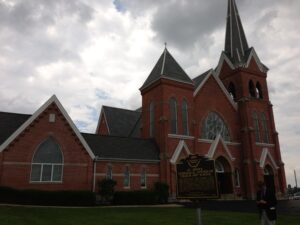, OH
“I say white brother, because I believe that to be the proper phrase, inasmuch as I believe in the principle of the fatherhood of God and the brotherhood of all mankind no matter what the color of his skin may be.” Richard L. Davis championed the cause of racial equality throughout the eastern coalfields, calling for an end to the color line and for all miners to unite against wage slavery. He was born in Roanoke County, Virginia in 1862 and arrived in racially integrated Rendville in 1882, where he became an organizer for the Knights of Labor. In 1886, a year after the Great Hocking Valley Strike, Davis wrote his first letters to the editor of the National Labor Tribune, establishing himself as voice for miners in the labor movement. (Continued on other side)
, OH
The Committee for Industrial Organization, later called the Congress of Industrial Organizations (CIO), formed the Steel Workers Organizing Committee (SWOC) under the leadership of CIO president John L. Lewis in April 1936. Following successful CIO strikes in the rubber and automobile industries, SWOC won contracts in early 1937 with the United States Steel Corporation and Jones and Laughlin Steel, the largest steel makers in the United States, also known as “Big Steel.” On May 26, 1937, SWOC struck three “Little Steel” companies whose operations were concentrated in the Mahoning Valley: Inland Steel, Republic Steel, and Youngstown Sheet and Tube. By early June, the first major steel strike since 1919 idled more than 28,000 Canton, Warren, and Youngstown steelworkers. (continued on other side)
, OH
In June 1815, Captain Jabez Burrell settled this land after coming from Sheffield, Massachusetts. Five years later the brick homestead was constructed. Five generations of the Burrell family occupied the homestead continuously from 1820 to January 2001 when Eleanor B. Burrell passed away. In 1836, the racially integrated Sheffield Manual Labor Institute, a branch of Oberlin College, was established at the Burrell Homestead, but the Institute closed the next year because the Ohio Legislature refused to grant its charter unless it excluded black students. From 1837 until the start of the Civil War, the homestead was a major stop on the Underground Railroad. Runaway slaves were hidden in the grain barn until Robbins Burrell could arrange for captains in Lorain, such as Aaron Root, to hide them on vessels for the trip across Lake Erie to freedom in Canada.
, OH
After embracing the cause of women’s suffrage, Harriet Taylor Upton (1854-1945) devoted her life to the movement. Born in Ravenna, she moved to Warren as a child and lived in this house beginning in 1873. Upton was treasurer of the National American Woman Suffrage Association from 1895 to 1910 and brought its headquarters to Warren in 1903, where it remained until 1910. She served as president of the Ohio Woman Suffrage Association for 18 years. As the first woman vice chair of the National Republican Executive Committee, Upton was instrumental in the passage of child labor laws and securing governmental appointments for women. Her devotion to women’s causes and skills as a public speaker earned her nationwide respect.
, OH
The Village of McGuffey was named for John McGuffey, who in the 1860s first attempted to drain the Scioto Marsh. A larger and more effective drainage effort, made by others who entered Hardin County in the 1880s, continued for several decades until thousands of acres of land were in production, principally of onions for which the marsh became nationally known. During the era of highest production of onions, most townspeople were involved in planting, weeding, and harvesting. The fields were bordered by windrows of willow trees to decrease wind damage over the black silt-like muck that was originally ten or more feet deep throughout the marsh. Successful treatment against wind erosion and oxidation reduced the depth of muck to only a few inches.
, OH
Attracted by the promotion of a civic group, as well as abundant fuel, Edward Drummond Libbey relocated his glass operation from Massachusetts to Toledo in 1888. His company was renown as a producer of fine art glass. Michael J. Owens, a Libbey Superintendent, developed the first fully automatic bottle-making machine in 1903. His invention revolutionized the industry and helped eliminate child labor in glass factories.
, OH
The Union Township Hall was a center of community life from the time of its construction around 1907. The hall included the offices of township government, a community hall, and club meeting rooms, a rarer combination in the 21st century. Local government and services occupied the first floor. The second floor “opera house” retains many original features, including the stage and stage backdrops. The hall hosted many types of entertainment, including church choirs and the Knights of Pythias Band. Leaving the township’s possession, the hall was used by various owners for a church, art studio, and bed and breakfast.(Continued on other side)
, OH
St. John’s Evangelical Lutheran Church was organized in 1838 by German Lutheran immigrants, primarily from Bavaria and Hesse-Darmstadt, who located in this vicinity in the 1830s. The congregation, called Neudettelsau, erected a second log church in 1843 centrally located in the “German Settlement”. A congregational split in 1846 resulted in the conservative members building a separate brick church a half mile away. This church in 1847 became one of the 12 charter members of the Lutheran Church-Missouri Synod. Growing membership required a larger brick church built on this site in 1860. In 1878 the two St. John’s congregations in the settlement reunited.









